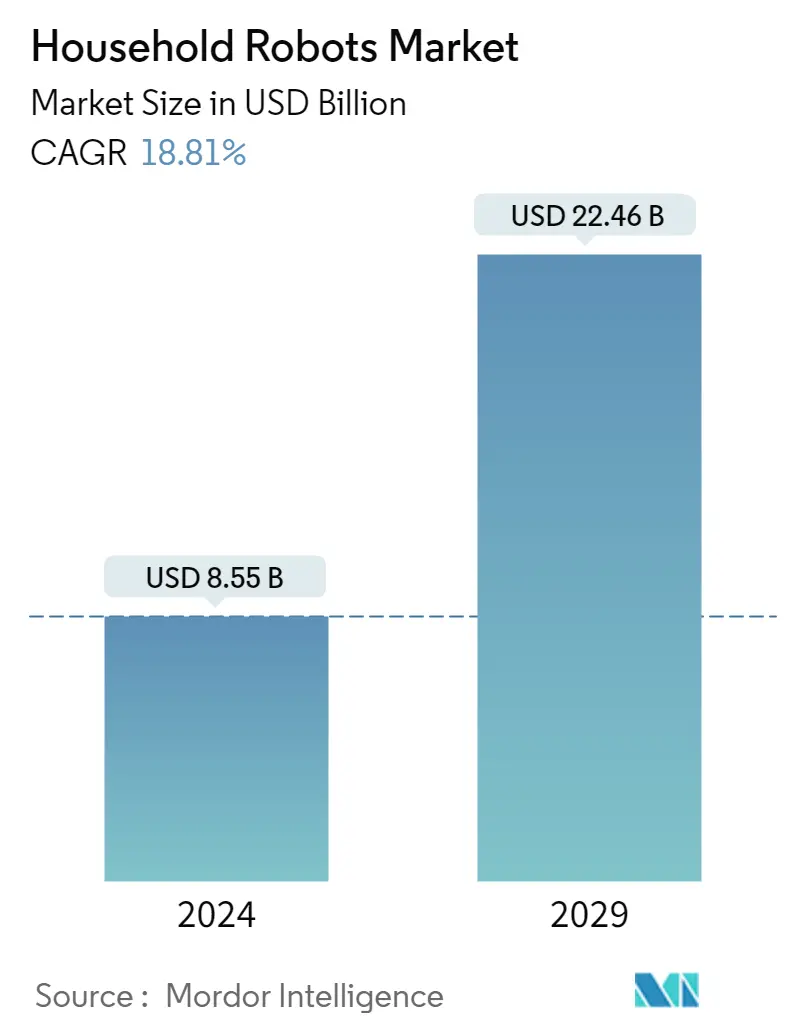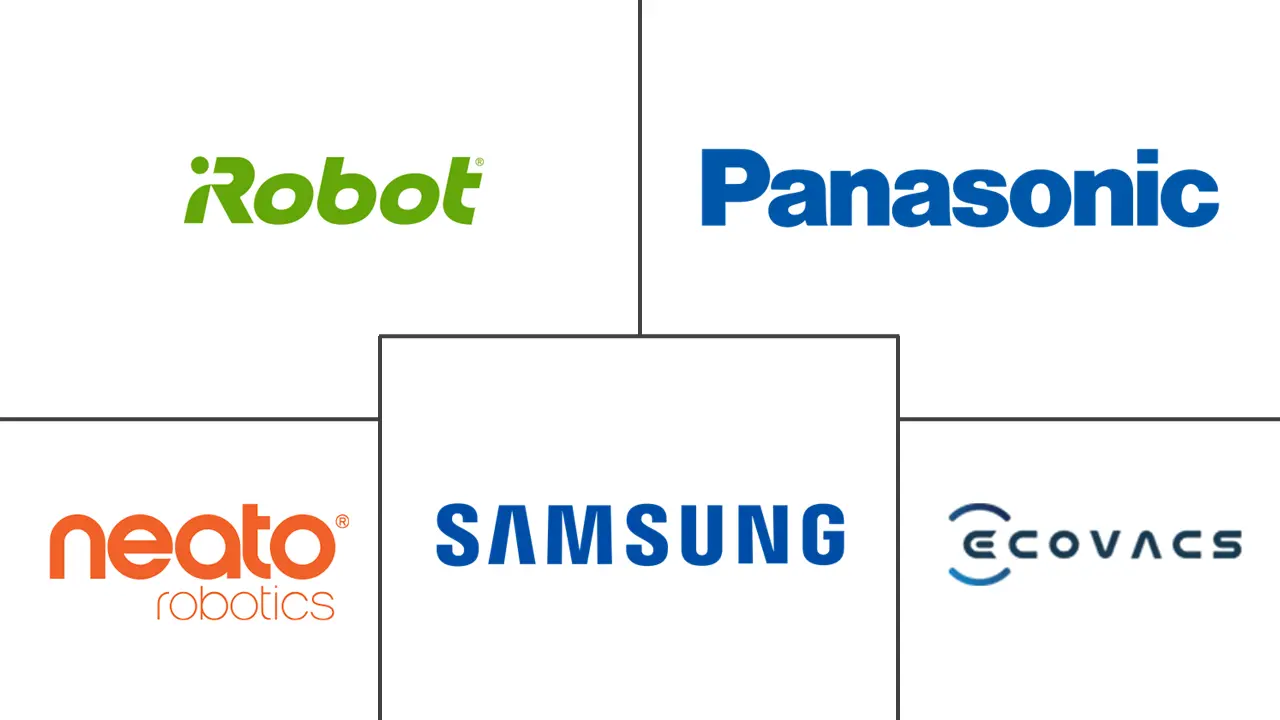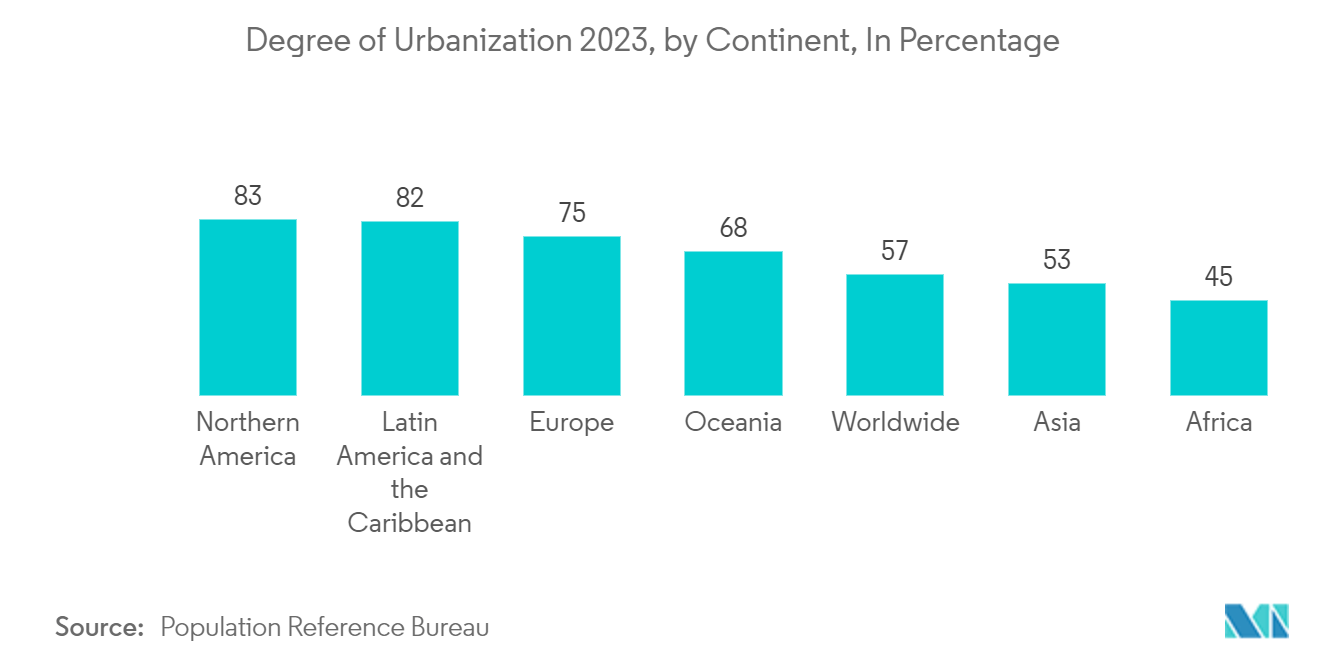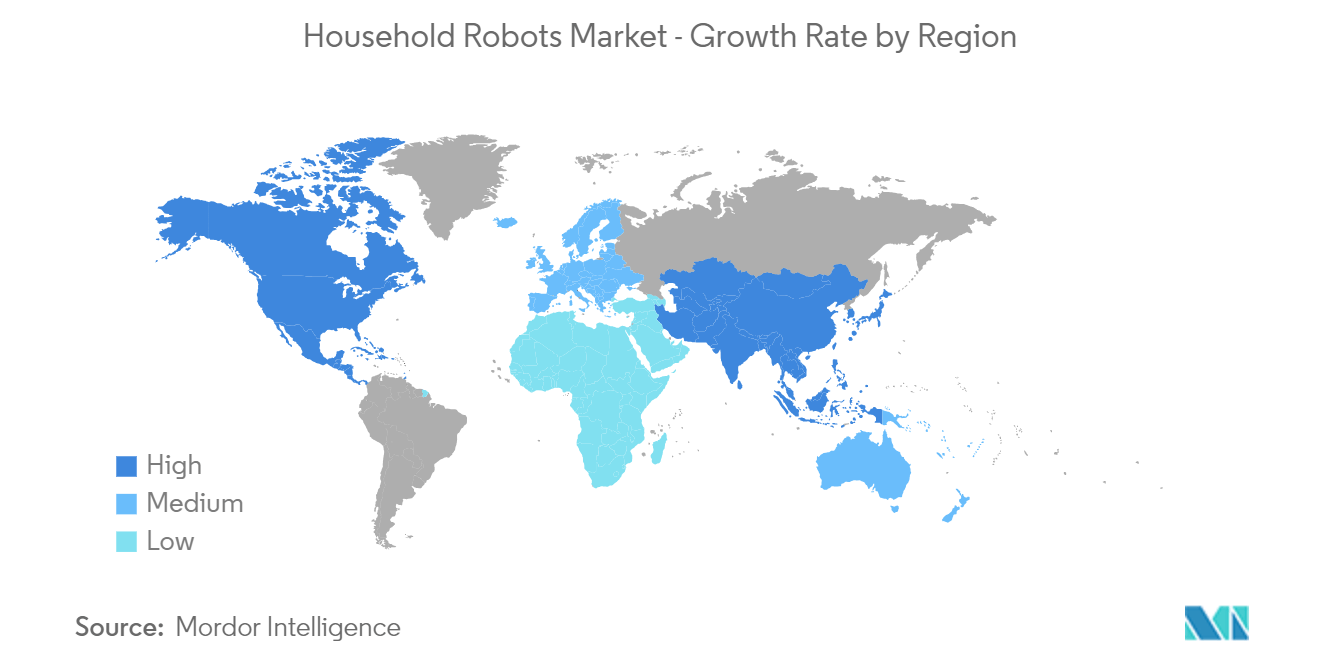Household Robots Market Size

| Study Period | 2019 - 2029 |
| Market Size (2024) | USD 8.55 Billion |
| Market Size (2029) | USD 22.46 Billion |
| CAGR (2024 - 2029) | 18.81 % |
| Fastest Growing Market | Asia Pacific |
| Largest Market | North America |
Major Players
*Disclaimer: Major Players sorted in no particular order |
Household Robots Market Analysis
The Household Robots Market size is estimated at USD 8.55 billion in 2024, and is expected to reach USD 22.46 billion by 2029, growing at a CAGR of 18.81% during the forecast period (2024-2029).
- Household robots, also known as domestic robots, are autonomous service robots that perform mundane tasks such as pool cleaning, floor cleaning, and lawn mowing. They can also be used for other things like entertainment, education, and elderly care.
- With the rapidly growing smart home concept, Robotics is expected to play a critical role in the overall smart home ecosystem. The reduction in household activities caused by the use of robotic vacuum cleaners is the primary driver of market growth. Modern households are becoming more computerized, providing convenience and reducing time spent on housework. While vacuum cleaners have made house cleaning easier, they produce noise and add bulk to everyday use.
- Moreover, one of the major factors driving the market is the increasing investment by companies worldwide in developing household robots for various applications. For example, Dyson, a British company, revealed a prototype of home robots capable of performing domestic chores in May 2022. The company also announced plans to construct the UK's largest robotics research facility.
- Other significant factors driving global demand for household robots include increasing automation in household appliances, rising labor costs in developed countries, and rising health and safety concerns. The increasing technological development in AI, robotics, and machine vision cameras, among others, aids market growth by effectively mapping floor edges, such as a staircase, and recognizing obstacles, such as cables, dustbins, doorsills, and rugs, allowing these robots to operate more smoothly and efficiently.
- Several initiatives being undertaken by the government and independent organizations to use technology to assist elderly people in maintaining their health and wellness, such as sleep, hydration, stress, and so on, are also driving demand for household robots. For example, the Olympic Area Agency on Aging (O3A) and Intuition Robotics announced a new program in March 2023 to provide ElliQ, an AI-driven care companion robot, to older adults in Grays Harbor and Pacific Counties who require additional assistance.
- However, the higher procurement and maintenance costs of these robots are among the significant factors impeding the growth of the studied market. To operate these robots efficiently, a certain level of technological know-how is required, which also poses a challenge to the market's development, particularly in developing regions.
- Despite the prices of home robots decreasing, these are still high enough to be adopted by mass consumers, especially in regions like Latin America and Africa. The increasing capabilities of cleaning robots have propelled the need for these robots' efficient performance, which further increases the cost. Additionally, policymakers and governments must also determine whether the technology deserves widespread application. For instance, in the cases of robotic vacuum cleaners and pool cleaners, it jeopardizes the jobs of several lower-income groups, which may lead to unemployment. Hence, such trends also challenge the studied market's growth.
Household Robots Market Trends
Robotic Vacuum and Mopping is Expected to Hold Major Share
- During the pandemic, high-quality professional household cleaning products became an obvious requirement for most people. As cleaning robots provide contactless and intelligent cleaning advantages over manual services, the pandemic outbreak has presented a strategic development opportunity in the household cleaning robot industry.
- Factors such as rapid urbanization are also anticipated to increase the demand for cleaning robots for vacuuming and mopping applications. For instance, the world is rapidly urbanizing, with more than 65 percent of the population expected to live in cities by 2050 (according to the WHO). In the current scenario, North America leads the world with 83 percent of the urban population, followed by Latin America and the Caribbean (81 percent) and Europe (75 percent) (Source: Population Reference Bureau).
- The rising number of working men and women in emerging economies has also increased demand for devices that can help save time when cleaning at home. The introduction of the Internet of Things (IoT) and Home Area Networks (HAN) technologies is expanding the residential application of cleaning robots.
- Moreover, Growing safety concerns about the use of hazardous chemicals by cleaning personnel and the implementation of stringent safety standards are expected to drive demand for robotic vacuums in the coming years. As the IoT framework is best suited to obtain accurate sensor results and perform the required tasks, the increased residential application of IoT-enabled robots supports segmental growth.
- Owing to the growing demand, market participants have been actively investing in providing advanced solutions. For example, in September 2022, robot Corp., a consumer robot leader, released the Roomba combo j7+, the world's most advanced robot vacuum and mop, and thoughtful robot OS 5.0 updates. The Roomba combo j7+ stands out from other 2-in-1 robots by vacuuming and mopping in a single cleaning job, saving time while keeping floors fresh and clean. It is designed for busy households with carpets, rugs, and hard floors and those who want a robot vacuum that can also mop.
- Similarly, the Philips R6 Slim Robot Vacuum Cleaner was released in China in January 2023. The vacuum would include a 0.4 L onboard dustbin, a 2,700 pa suction power, and several brushes to help remove and capture debris. The two mop heads on the robot vacuum cleaner could rotate up to 120 times per minute and exert 6 N of force while cleaning the owners' floors. During the projection period, the company's actions are anticipated to increase demand for robotic vacuum cleaners.

Demand in Asia-Pacific is Expected to Grow Significantly
- The Asia-Pacific region is expected to drive the market by growing significantly as a result of the widespread adoption of household robots in economies such as China, Japan, and India. The rapid development of robotic systems by Chinese and Japanese companies may increase the demand for and consumption of cleaning robots in the region.
- The region is one of the rapidly growing cleaning robot markets, owing to widespread technology adoption and rising domestic production. Regional vendors also play an essential role in cleaning robot innovation and development. For example, Haier, a leading consumer electronics brand, launched its first-ever wise vacuum cleaner in India in May 2022. The robot vacuum cleaner with a 2-in-1 dry and wet mop has 2.4 GHz Wi-Fi, Google Home Assistant, and smart management features such as the Haier smart app, voice control, and remote control.
- Among the significant factors driving demand for household robots in the region are the region's growing urbanization rate and the changing lifestyle of the population. According to the Population Reference Bureau, China and India's urban populations are expected to grow by more than 340 million by 2030. Even a small country like Laos is expected to add about 3.2 million people to its urban population while remaining only 43 percent urbanized by 2030.
- Various government initiatives and regulations promoting the growth of the robotics industry are also creating a favorable environment for market growth by facilitating inter-organizational collaboration, which results in the development of innovative technologies. For example, the Chinese government has identified the robotics industry as critical to its economic strategy in its 14th Five-Year Plan. By 2025, China plans to become a significant source of global robotics innovation.
- Moreover, A rising elderly population, especially in countries such as China and Japan, is also expected to remain among the major factors driving the demand for household robots. According to the U.S. Census Bureau, by 2060, about 33.7 percent of Eastern Asia's population is projected to be 65 and older. In contrast, Southern Asia (18.6 percent) and Western Asia (17.9 percent) are expected to have the lowest proportions of older people during the same period.
- Additionally, the rising demand encourages new players to enter the market, increasing competition between the vendors. In addition to the entry of established market players, rising demand is boosting the region's startup ecosystem. Hence, such trends are expected to contribute positively to market growth during the forecast period, from driving demand for cleaning robots to the need for humanoid robots for entertainment and companionship.

Household Robots Industry Overview
The household robots market is fragmented with the presence of major players like iRobot Corporation, Neato Robotics Inc., Samsung Electronics Co. Ltd, Ecovacs Robotics Inc., and Panasonic Corporation. Players in the market are adopting strategies such as partnerships, innovations, and acquisitions to enhance their product offerings and gain sustainable competitive advantage.
- In May 2023, A Japanese artificial intelligence (AI) startup firm launched a robot for residential applications. The newly launched robot is capable of delivering items when given verbal commands, such as bringing condiments and dishes to the dining room table or drinks or books to the sofa. Developed by Tokyo-based Preferred Robotics Inc., the robot is called "Kachaka" and attaches to the bottom of tables fitted with caster wheels.
- In January 2023, Roborock Technology Co. Ltd. introduced its S8 Series of flagship robot vacuums, including the Roborock S8 Pro Ultra, Roborock S8+, and the Roborock S8. These robots come with the intelligence to easily move around the home, offering hands-off deep cleaning capabilities better than ever before.
Household Robots Market Leaders
-
iRobot Corporation
-
Neato Robotics Inc.
-
Samsung Electronics Co. Ltd
-
Ecovacs Robotics Inc.
-
Panasonic Corporation
*Disclaimer: Major Players sorted in no particular order
.webp)
Household Robots Market News
- April 2024 - iRobot Corp introduced the Roomba combo essential robot an affordable and easy-to use 2-in-1 robot vacuum and mop. At USD 275, the Roomba Combo Essential delivers the cleaning essentials customers loved about the best-selling1 Roomba 600 Series – but with better performance and an impressive set of features that make it even simpler to clean the way they want. The company also announced it has surpassed the milestone of selling more than 50 million robots worldwide
- January 2024 - ECOVACS is unveiling the future of whole home robotics, including revolutionary for robots for floor, air, ceiling, window, and lawn care. The DEEBOT X2 COMBO, a new iteration of the award-winning X2 OMNI and the next-generation WINBOT W2 OMNI showcase cutting-edge features and embody ECOVACS’ core mission of ‘Robotics for All’. X2 COMBO includes upgraded handsfree capabilities and precision to clean floors, curtains, ceilings or other surfaces in a fully automated way, which will enable users to take full advantage of the new era of whole house cleaning
Household Robots Market Report - Table of Contents
1. INTRODUCTION
- 1.1 Study Assumptions and Market Definition
- 1.2 Scope of the Study
2. RESEARCH METHODOLOGY
3. EXECUTIVE SUMMARY
4. MARKET INSIGHTS
- 4.1 Market Overview
-
4.2 Industry Attractiveness - Porter's Five Forces Analysis
- 4.2.1 Bargaining Power of Suppliers
- 4.2.2 Bargaining Power of Buyers
- 4.2.3 Threat of New Entrants
- 4.2.4 Threat of Substitute Products
- 4.2.5 Degree of Competition
- 4.3 Industry Value Chain Analysis
- 4.4 Impact of Macro Trends on the Industry
5. MARKET DYNAMICS
-
5.1 Market Drivers
- 5.1.1 Growing Research and Development Investments and Wide Range of Applications
- 5.1.2 Rapid Urbanization
-
5.2 Market Restraints
- 5.2.1 High Cost of Equipment
6. MARKET SEGMENTATION
-
6.1 By Application
- 6.1.1 Robotic Vacuum and Mopping
- 6.1.2 Lawn Mowing
- 6.1.3 Pool Cleaning
- 6.1.4 Companionship and Other Applications
-
6.2 By Geography
- 6.2.1 North America
- 6.2.2 Europe
- 6.2.3 Asia
- 6.2.4 Australia and New Zealand
- 6.2.5 Latin America
- 6.2.6 Middle East and Africa
7. COMPETITIVE LANDSCAPE
-
7.1 Company Profiles
- 7.1.1 iRobot Corporation
- 7.1.2 Neato Robotics Inc.
- 7.1.3 Samsung Electronics Co. Ltd.
- 7.1.4 Ecovacs Robotics Inc.
- 7.1.5 Panasonic Corporation
- 7.1.6 LG Electronics Inc.
- 7.1.7 Blue Frog Robotics Inc.
- 7.1.8 Roborock Technology Co. Ltd.
- 7.1.9 Husqvarna Group
- 7.1.10 ILIFE Innovation Ltd.
- 7.1.11 bObsweep Inc.
- 7.1.12 SharkNinja Operating LLC
- 7.1.13 Maytronics Ltd.
- *List Not Exhaustive
8. INVESTMENT ANALYSIS
9. MARKET OPPORTUNITIES AND FUTURE TRENDS
** Subject To AvailablityHousehold Robots Industry Segmentation
Household robots are autonomous devices capable of cleaning the floor, pool, windows, and lawns without human intervention. Household robots, such as robot vacuum cleaners, are used for residential properties. The study tracks the demand trends for household robots across various market segments, including application areas and geography.
The household robot market is segmented by application (robotic vacuum and mopping, lawn mowing, pool cleaning, companionship) and geography (North America, Europe, Asia-Pacific, Rest of the World).
The market sizes and forecasts are provided in terms of value in (USD) for all the above segments.
| By Application | Robotic Vacuum and Mopping |
| Lawn Mowing | |
| Pool Cleaning | |
| Companionship and Other Applications | |
| By Geography | North America |
| Europe | |
| Asia | |
| Australia and New Zealand | |
| Latin America | |
| Middle East and Africa |
Household Robots Market Research Faqs
How big is the Household Robots Market?
The Household Robots Market size is expected to reach USD 8.55 billion in 2024 and grow at a CAGR of 18.81% to reach USD 22.46 billion by 2029.
What is the current Household Robots Market size?
In 2024, the Household Robots Market size is expected to reach USD 8.55 billion.
Who are the key players in Household Robots Market?
iRobot Corporation, Neato Robotics Inc., Samsung Electronics Co. Ltd, Ecovacs Robotics Inc. and Panasonic Corporation are the major companies operating in the Household Robots Market.
Which is the fastest growing region in Household Robots Market?
Asia Pacific is estimated to grow at the highest CAGR over the forecast period (2024-2029).
Which region has the biggest share in Household Robots Market?
In 2024, the North America accounts for the largest market share in Household Robots Market.
What years does this Household Robots Market cover, and what was the market size in 2023?
In 2023, the Household Robots Market size was estimated at USD 6.94 billion. The report covers the Household Robots Market historical market size for years: 2019, 2020, 2021, 2022 and 2023. The report also forecasts the Household Robots Market size for years: 2024, 2025, 2026, 2027, 2028 and 2029.
Household Robots Industry Report
Statistics for the 2024 Household Robots market share, size and revenue growth rate, created by Mordor Intelligence™ Industry Reports. Household Robots analysis includes a market forecast outlook to for 2024 to 2029 and historical overview. Get a sample of this industry analysis as a free report PDF download.



